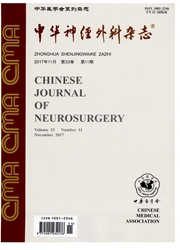

 中文摘要:
中文摘要:
目的探讨体内外原代培养的人脑胶质瘤干细胞(GSCs)与胶质瘤新生血管内皮细胞的关系。方法新鲜高级别(WHOⅢ级、Ⅳ级)的人脑胶质瘤标本经原代培养获取GSCs,免疫组化法检测其肿瘤干细胞及干细胞标记物Nestin的表达;鉴定后的GSCs经低氧诱导,免疫荧光法检测其诱导分化后内皮细胞标记物CD31、CD144和胶质瘤细胞标记物GFAP的表达,RT—PCR和Western—blot法检测其CD31的表达;建立胶质瘤干细胞皮下荷瘤裸鼠模型,免疫组化技术检测模型中人来源的CD31的表达。结果(1)悬浮生长的胶质瘤干细胞球样细胞经免疫组化鉴定Nestin表达阳性;(2)低氧诱导后的GSCs能够表达CD31、CD144,有些细胞能够同时表达CD144和GFAP;(3)RT—PCR检测发现GSCs在诱导前后都有CD31mRNA的表达,而Western—blot检测到只有诱导后的GSCs有CD31蛋白的表达;(4)胶质瘤干细胞荷瘤裸鼠模型的肿瘤组织中部分微血管抗人CD31抗体染色阳性。结论胶质瘤干细胞不仅在体外低氧条件下可分化为内皮细胞,在体内微环境条件下同样可分化为血管内皮细胞,并参与胶质瘤新生组织的血液供应。
 英文摘要:
英文摘要:
Objective With the development of glioblastoma therapy, the view on inhibiting angiogenesis had reached a general consensus, but the efficacy is not satisfactory. It is important to study the relationships between glioma stem cells (GSCs) and endothelial cells, which might provide a new therapeutic target to improve the prognosis of glioblastoma. Methods We isolated the GSCs from 38 specimens and cultured them as spheres in serum - free medium. After incubating in vitro for 4 h under hypoxia, we observed the expression of the endothelial cell markers CD31 and CD144 and glial fibrillary acidic protein (GFAP) by immunofluorescence staining, RT - PCR and Western - blotting. In the xenografts of transplanted tumors established by GSCs spheres, we detected vessels with an anti - human endothelial cell antiboy. Results CD31 and CD144 were expressed in transdifferentiated cells in vitro, as determined with immunofluorescence staining and Western - blot analysis. Additionally, at the mRNA level we found that both the GSCs and the transdifferentiated cells expressed the endothelial cell markers. Some micro-vessels in vivo were CD31 positive in the immunofluorescence staining. Conclusions demonstrates that GSCs have the ability to differentiate into endothelial cells. Our study
 同期刊论文项目
同期刊论文项目
 同项目期刊论文
同项目期刊论文
 Glioma stem cells targeted by oncolytic virus carrying Endostatin-Angiostatin fusion gene and the ex
Glioma stem cells targeted by oncolytic virus carrying Endostatin-Angiostatin fusion gene and the ex 期刊信息
期刊信息
